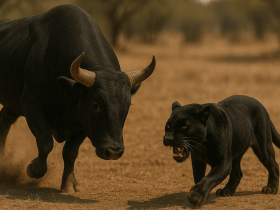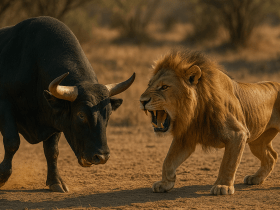Below is a full detailed article about Nile crocodile vs Rhino.
Nile crocodile (Crocodylus niloticus)
rhinoceros (specifically the black rhino, Diceros bicornis, and white rhino, Ceratotherium simum)
Below tables cover 10 main topics by including all the numerical and scientifical data by comparing Nile crocodile vs Rhino. Also I have included a winner column for further understanding, Hope you will enjoy!
1. Body Specifications
| Feature | Nile Crocodile | Rhino (White & Black) | Winner |
|---|---|---|---|
| Length | 4–6 m | 3–4 m (body), horn up to 1.5 m | Crocodile |
| Height | ~0.6 m at shoulder | 1.4–1.8 m at shoulder | Rhino |
| Weight | 500–1,200 kg | 800–2,300 kg | Rhino |
| Body Shape | Elongated, flat | Thick, barrel-like | Tie |
| Skin Thickness | 4–5 cm | ~2.5 cm | Crocodile |
| Bone Density | High (buoyancy support) | Extremely dense | Rhino |
| Muscle Mass | Primarily in tail and jaws | All-around power | Rhino |
| Skull Size | 65–75 cm | ~50–60 cm (horn adds length) | Crocodile |
| Defensive Armor | Bony osteoderms | Tough hide, no armor | Crocodile |
| Mobility | Semi-aquatic | Terrestrial | Tie |
Winner: Tie (Crocodile for length & armor; Rhino for mass & power)
2. Coat and Coloration
| Feature | Nile Crocodile | Rhino | Winner |
|---|---|---|---|
| Color | Olive to dark brown | Gray to brown | Tie |
| Pattern | Mottled scales | Solid color | Crocodile |
| Function | Camouflage in water | Camouflage in dust | Tie |
| Melanin Levels | Moderate | Moderate | Tie |
| Skin Texture | Rough, armored | Tough, leathery | Tie |
| Temperature Regulation | Through basking | Via skin folds and mud | Tie |
| Parasite Defense | Birds like plovers clean them | Mud bathing | Tie |
| Shedding | Rare, peels in flakes | Not significant | Crocodile |
| UV Resistance | High | High | Tie |
| Sensory Function of Skin | Pressure sensors | Low | Crocodile |
Winner: Crocodile
3. Habitat and Range – Nile crocodile vs Rhino
| Feature | Nile Crocodile | Rhino | Winner |
|---|---|---|---|
| Geographic Range | Sub-Saharan Africa, Nile Basin | Sub-Saharan Africa | Tie |
| Habitat Type | Rivers, lakes, swamps | Grasslands, savannas | Tie |
| Habitat Size | 100s of square km | ~50–100 sq km per rhino | Crocodile |
| Water Dependency | High | Moderate | Crocodile |
| Altitude Tolerance | Lowlands preferred | Up to 2,000 m | Rhino |
| Heat Tolerance | Extreme | High | Tie |
| Climate Flexibility | Tropical to arid | Arid to semi-humid | Tie |
| Range Fragmentation | Less than rhinos | Severe | Crocodile |
| Territorial Defense | Nesting areas | Entire range | Rhino |
| Range Overlap | Often intersect at watering holes | Often intersect at watering holes | Tie |
Winner: Tie
4. Diet and Hunting Behavior
| Feature | Nile Crocodile | Rhino | Winner |
|---|---|---|---|
| Diet Type | Carnivore | Herbivore | N/A |
| Prey Size | Small to large mammals | N/A | Crocodile |
| Hunting Method | Ambush predator | N/A | Crocodile |
| Kill Method | Death roll, drowning, crush | N/A | Crocodile |
| Daily Caloric Need | 3,000–5,000 kcal | 50,000–60,000 kcal | Rhino |
| Feeding Frequency | Once every few days | Grazes daily | Tie |
| Digestion Rate | Very slow | Fast | Rhino |
| Scavenging Behavior | Occasional | Never | Crocodile |
| Tool Use | None | None | Tie |
| Foraging Range | Within 1–2 km of water | Wide grazing range | Rhino |
Winner: Crocodile
5. Strength and Bite Force – Nile crocodile vs Rhino
| Feature | Nile Crocodile | Rhino | Winner |
|---|---|---|---|
| Bite Force | ~16,460 N (~3,700 PSI) | Not bite-reliant | Crocodile |
| Jaw Strength | Extreme (one of strongest in animal kingdom) | Not jaw-focused | Crocodile |
| Neck Strength | Strong for gripping prey | Powerful for charging | Rhino |
| Leg Strength | Short but powerful push-off | Massive limb force | Rhino |
| Horn Strength | N/A | Up to 3.6 tonnes of force on impact | Rhino |
| Lifting Capacity | Limited | Can flip smaller vehicles (~900 kg) | Rhino |
| Gripping Ability | Jaws only | N/A | Crocodile |
| Death Grip | Yes (locks prey underwater) | N/A | Crocodile |
| Tail Power | Can knock prey off balance | Minimal use | Crocodile |
| Force in Charge | N/A | ~5,000 N+ | Rhino |
Winner: Tie (Crocodile in bite strength, Rhino in brute force)
6. ⚡ Speed and Agility
| Feature | Nile Crocodile | Rhino | Winner |
|---|---|---|---|
| Land Speed | 14 km/h (short burst) | 40–50 km/h (short burst) | Rhino |
| Water Speed | 30 km/h (burst) | Poor swimmer | Crocodile |
| Acceleration | Moderate | High for size | Rhino |
| Turning Radius | Poor on land | Poor | Tie |
| Agility in Water | Excellent | N/A | Crocodile |
| Agility on Land | Poor | Moderate | Rhino |
| Climbing Ability | None | None | Tie |
| Endurance | Low | Moderate | Rhino |
| Vertical Jump | None | None | Tie |
| Terrain Flexibility | Water-based | Land-based | Tie |
Winner: Tie (Rhino wins land mobility, Crocodile dominates in water)
7. Sensory Abilities – Nile crocodile vs Rhino
| Feature | Nile Crocodile | Rhino | Winner |
|---|---|---|---|
| Vision (Day) | Good | Moderate | Crocodile |
| Vision (Night) | Excellent (tapetum lucidum) | Poor | Crocodile |
| Hearing | Moderate | Good | Rhino |
| Smell | Poor | Excellent | Rhino |
| Pressure Sensitivity | ISOs (Integumentary sensory organs) | None | Crocodile |
| Vibration Detection | Strong via water | Ground-based | Tie |
| Underwater Awareness | High | N/A | Crocodile |
| Olfactory Range | Low | Kilometers | Rhino |
| Depth Perception | Limited | Poor | Tie |
| Sensory Reliance | Eyes & ISOs | Nose & ears | Tie |
Winner: Tie (Crocodile excels in aquatic senses; rhino dominates olfactory perception)
8. Reproduction and Lifespan
| Feature | Nile Crocodile | Rhino | Winner |
|---|---|---|---|
| Gestation Period | ~90 days (eggs) | 15–16 months (live birth) | Rhino |
| Offspring Count | 20–80 eggs | 1 calf | Crocodile |
| Birth Weight | ~70 g (hatchling) | 35–65 kg | Rhino |
| Parental Care | Female guards nest | Strong maternal care | Rhino |
| Sexual Maturity | 10–12 years | 6–10 years | Tie |
| Lifespan (Wild) | 50–70 years | 35–50 years | Crocodile |
| Lifespan (Captivity) | Up to 100 years | Up to 50 years | Crocodile |
| Infant Mortality | Very high | Moderate | Rhino |
| Breeding Frequency | 2–3 years | 2.5–5 years | Crocodile |
| Reproductive Success Rate | Low due to predation | Low due to poaching | Tie |
Winner: Tie (Crocodile for quantity & lifespan; Rhino for quality & investment)
9. Social Behavior – Nile crocodile vs Rhino
| Feature | Nile Crocodile | Rhino | Winner |
|---|---|---|---|
| Social Structure | Mostly solitary | Solitary (Black), Semi-social (White) | Tie |
| Territory Size | ~1 km² for dominant males | Up to 100 km² | Rhino |
| Aggressiveness | Very high | High when threatened | Tie |
| Parental Roles | Female only | Female only | Tie |
| Intraspecies Conflict | Violent | Horn clashes, some lethal | Tie |
| Communication | Hisses, growls, body language | Grunts, snorts, scent | Rhino |
| Hierarchy | Dominance at basking spots | Not clear | Crocodile |
| Migratory Patterns | Minimal | Seasonal in drought | Rhino |
| Group Defense | None | Females defend calves | Rhino |
| Mating Behavior | Aggressive | Selective | Rhino |
Winner: Rhino
10. Conservation Status – Nile crocodile vs Rhino
| Feature | Nile Crocodile | Rhino | Winner |
|---|---|---|---|
| IUCN Status | Least Concern | Endangered (Black), Near Threatened (White) | Crocodile |
| Population Trend | Stable | Declining | Crocodile |
| Major Threats | Habitat loss, poaching | Poaching for horn | Tie |
| Conservation Priority | Medium | Very high | Rhino |
| Protection Level | CITES Appendix I/II | CITES Appendix I | Rhino |
| Habitat Encroachment | Moderate | High | Crocodile |
| Captive Breeding | Successful | Limited success | Crocodile |
| Poaching Pressure | Moderate | Severe | Crocodile |
| Reintroduction Programs | Few | Multiple | Rhino |
| Human-Wildlife Conflict | High | Very high | Tie |
Winner: Crocodile
Face-to-Face Fight Analysis
In a direct confrontation between a Nile crocodile and a rhino, the outcome depends heavily on the environment:
- In water: The crocodile has the advantage. Its stealth, death roll, and crushing bite could target a leg if the rhino strays into deep water. Though not easy, ambush could injure or drown a young or sick rhino.
- On land: The rhino dominates. Its sheer size, horn, speed, and momentum would crush the crocodile before it could react. A full-speed charge could break the crocodile’s ribs or skull.
Neutral Ground (riverbank or shallow water): The rhino still has the edge. It’s rare for a croc to take on a healthy adult rhino unless caught off guard.
Overall Winner: Rhino
✅ Reasons Why the Rhino Wins:
- Superior strength and bulk on land.
- Powerful horn capable of killing with one charge.
- Greater mobility and acceleration on dry terrain.
- Highly resistant to ambush once aware.
- Thick hide resists bite damage in many cases.
❌ Why the Crocodile Loses:
- Relies on stealth and water.
- Vulnerable on land to trampling or goring.
- Cannot overpower a rhino outside perfect ambush conditions.
References
- IUCN Red List – Crocodylus niloticus
- IUCN Red List – Diceros bicornis
- National Geographic – Nile Crocodile
- WWF – Rhino Conservation
- Scientific American – Animal Bite Forces
Read More – Crocodile vs Hippopotamus : A Comprehensive Comparison






Leave a Reply